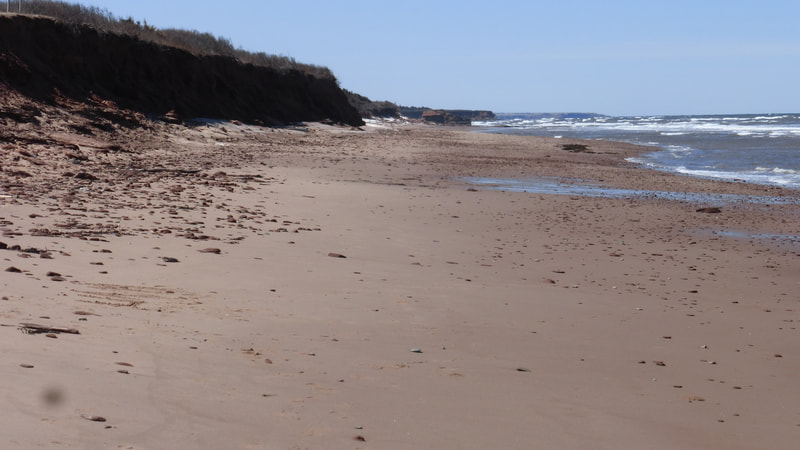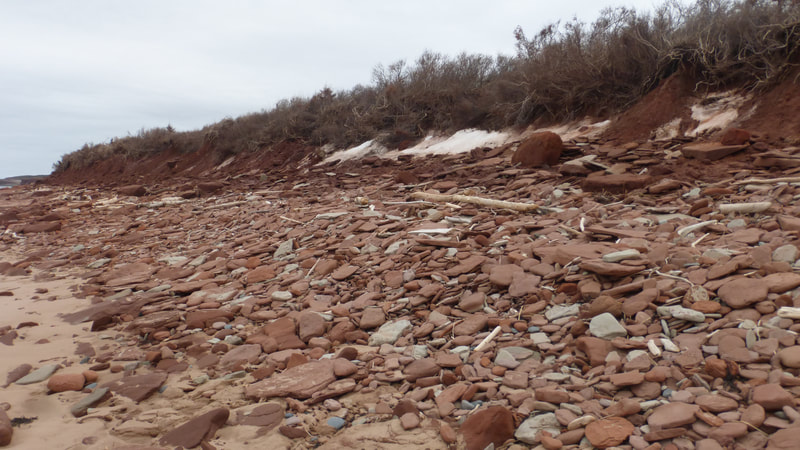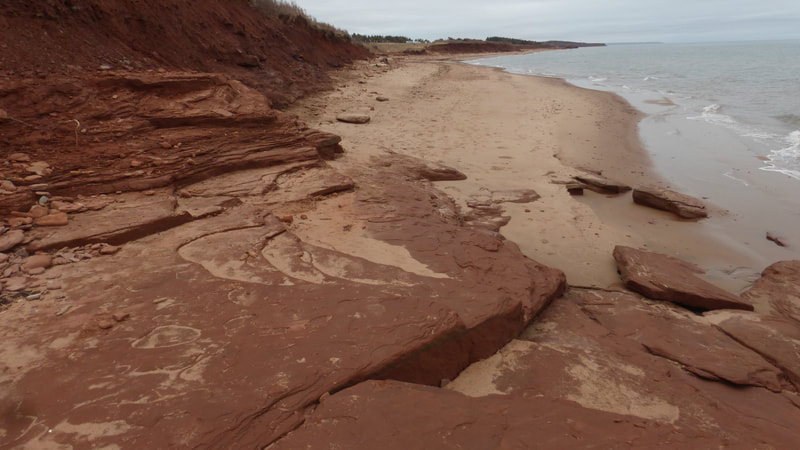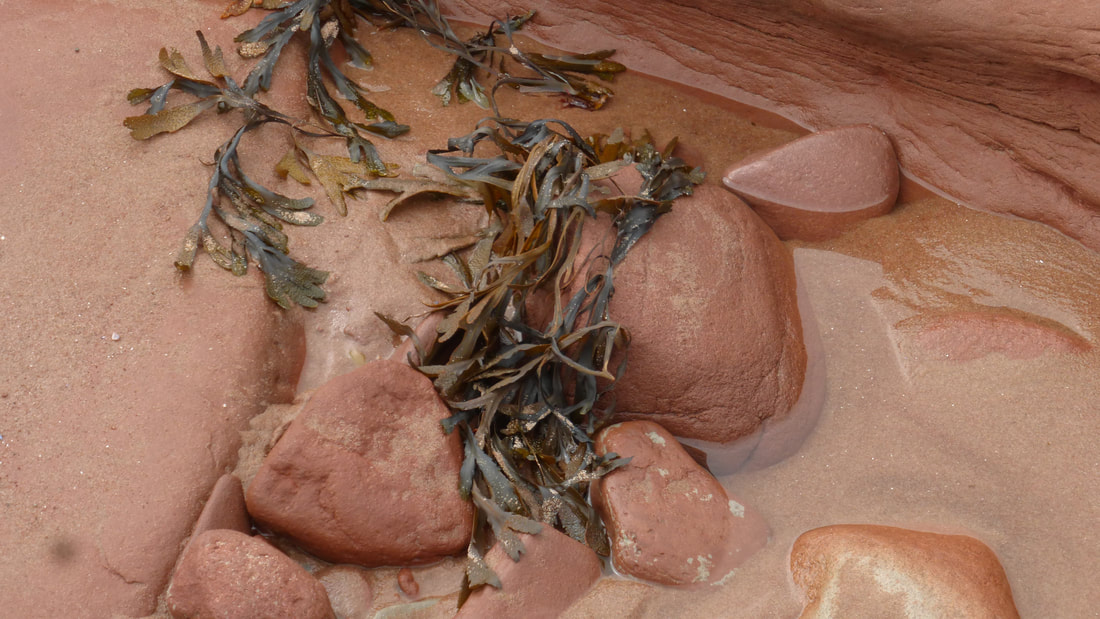Low cliffs of red soil and sandstone separate the shoreline ground from the higher brushy fields and woods further inland. In some places along the shore there is sandy beach; in others places the ground is covered with loose rock shingles and slabs, or consists of stacked platforms of sandstone bedrock. Many patches of the waterfront have mixed-material ground: large slabs resting on sand, rocky cliff-base areas grading into sand closer to the ocean, or wide sand beach with bedrock surprisingly re-emerging at water's edge. In short, this stretch of coast presents great variety of visual mood and terrain near the water, backed by a significant barrier to those wishing to pass between woods and shore.
Dimensions The extent of low beach/rocky ground between the cliffs and the water's edge varies from 15 to 50 yards/meters, depending on location as well as state of the tide. The cliff height averages 15 feet (5 meters), varying from 6 feet (2 meters) to 25 feet (8 meters). Loose rock slabs are half a yard/meter to 4 yards/meters across.
Key Details

- The edge of the land here is being assaulted by the waves' erosive energy, exploiting the sandstone's beds and fractures. Weaker layers of the rock disintegrate into loose sand and silt, and even more solid ones break up into individual slabs that drop to the cliff base. Rocks tumbled by the waves knock against each other, smoothing their rough edges and fragmenting them into round pebbles.
- The tides rise and fall by a foot or two here (about 0.5 meters), moving the waterline many yards/meters horizontally onto the land and away from it each day. High tides and large waves during storms periodically bring wave erosion right to the bases of the cliffs, eating further away at the rock year by year.
- While the largest loose pieces of sandstone on the low shore ground are flat slabs, many substantial ones have odd rounded shapes, and all of them are annually re-tossed by storm waves. This makes any group of loose rocks a place to walk carefully. Even a large slab might shift under a person's weight, and the smooth surfaces of boulders make it easier for a foot to slip down into a narrow gap between them.
- Rock slabs near the water's edge might have a thin sheen of algae that makes their surfaces very slippery, a strong contrast to the good footing that clean sandstone (dry or moist) provides.
- Some bedrock platforms below the cliffs are clear of loose stones and other debris, providing stable footing and a chance for safe running. Such a clear path along the shore might be blocked by high tide or the new scattering of debris from a recent storm.
- While many of the smaller, fist-sized stones and pebbles here are made of the red sandstone, some have strikingly different colors and surface patterns. These are mixed igneous and metamorphic rocks from far away, dropped on this region by the melting of an ancient continental glacier. Most of the off-colored stones are harder than the sandstone, not so easily fragmented by the waves.
- The cliffs here are near-vertical, with small ledges where strong sandstone beds jut out. They are difficult to climb because much of the cliff-face material is crumbly and some rock slabs are loose, ready to fail if used for a hand- or foot-hold. Thin soil at top of the cliff is capped by dense-rooted turf.
- The sandy beach has a red tinge, though milder in color than the rocks and cliffs. Moist sand surfaces near the water's edge require least effort in walking; fully dry sand shifts under each footstep, saps energy, and slows progress. The dry sand can bear heavy weight, however, including that of vehicles, mounts, and beached watercraft. A significant depth of sand is eroded from the beach each year by strong winter waves, stored in the nearby sea bed, and then slowly washed back up onto the beach in spring and summer. This means that permanent construction on the beach surface is impossible without a preliminary excavation down to solid bedrock.
- While much smoother-surfaced than the nearby rock ledges and jumbled stones, the sandy beach areas still have many detail features a beachcomber might happen upon. In addition to natural objects pictured below, human occupation of the region may have contributed beach glass, brick fragments, and water-borne litter.

- A few driftwood logs are scattered along the shore, half-buried in beach sand or mixed in with jumbled stones.
- Waterline patches of bedrock are clearly visible in some sandy beach locations. Other low rock outcrops may be under the water, only signaled by waves breaking above them.
- Raised sandbar ridges nearly parallel to the shore might also be resting below the water surface. These slowly migrate toward the land, as part of the return of beach sand to the shore in mild weather. Where a bar merges onto the beach at the water's edge, it can create a long, sandy, sideways sliver of peninsula which protects a shallow lagoon of quiet water on its shore side, from the incoming waves.
- Seagulls and other shore birds mix with crows on this shore, sometimes filling the air with their rough cries.
- Many shorelines in other regions have rocky headlands separated by inset, crescent beaches. But here the land's edge is a fairly even line, despite the quite different types of material composing parts of the waterfront. This means that very long-distance views down the shoreline are available to people standing near the water. If other people further down on the beachfront are hidden from view, that is more likely to be due to the gentle rise of bedrock platforms being in the way, than protruding cliffs.
- The waterline of recent high tides is fairly easy to discern, about anywhere along the shore. It is typically marked by a denser line of dried seaweed, other flotsam, and possibly a subtle color change in rock surfaces or beach sand.

- The shore's aspect varies considerably with weather.
- A cloudy day can still allow distant objects to be visible far down the shore and out to sea. Bright sun on the water can dazzle the eyes, while it brings small objects on the shore into sharp relief.
- Under a clear night sky, the low waterfront might allow better long-distance and celestial viewing than cliff-top areas washed by artificial light from dwellings and campfires.
- Fog obscures all but the closest land and water. Low-lying sea mist can creep to the shore very quickly, early in the day. It can severely degrade vision for those on the beach while views from the cliff tops are unobstructed.
- In winter and spring, snow and ice can blanket the waterfront entirely, or only above the recent high tide level.
- A cloudy day can still allow distant objects to be visible far down the shore and out to sea. Bright sun on the water can dazzle the eyes, while it brings small objects on the shore into sharp relief.
- Groundwater seeping from the cliff face leaves some patches of the wall continually moist, and creates small ice-falls in cold weather.
- A creek drains out across the beach in one place, bringing fresh water from further inland. Its bed is cut down about four inches (0.1 meters) into the beach, and almost completely paved with pebbles. At high tide level the creek crosses larger loose slabs of rock, a sort of micro-cascade with lots of available stepping-stones.
- The spot where the creek crosses the beach is also the location where bluff height is the lowest, more of a rough ramp than a cliff - an easily negotiable step up onto the inland creek valley's floor.
Story Elements

- This is a setting where someone might have a long vigil waiting for something to arrive from the sea, possibly only visible at the last moment in rain or fog.
- This would be a challenging place to transport a boat from inland to the water's edge, or cargo in either direction.
- A character walking down the length of this shore will need to give considerable attention to which ground areas are easiest to walk on, where rocks might be unstable, and opportunities to safely descend or ascend the cliff. Local residents will be familiar with the tide cycles and understand how safe it is to wade out in the water to bypass difficult spots on the shorefront.
- Wave-sculpted softened curves of bedrock and slabs below the cliff base are accentuated by the lines of fine layering in the sandstone. This gives an uncertain, otherworldly feel to the scene, especially at twilight or in fog.
- Because the low ground is so separate and visually shielded from the lands above, it could be a route to circumvent political/social barriers, sneak off school property, travel down the coast while necessarily avoiding roads, and generally escape prying eyes and general society.
- In nice weather, someone accustomed to solitude on this shore might be thwarted by the appearance of holiday crowds.
- If a group of boats makes landfall together on this shore, some crews will have quite different landing experiences than others. Those arriving on sandy beach areas will find it much easier to drag boats up from the water than those stepping up onto rock slabs. A few are likely to run aground on submerged bedrock or sand bars many yards/meters from the land's edge.

- Driftwood found well above the waterline should be excellent material for a campfire, so long as the pieces are reasonably small or can be split from larger logs. Dried seaweed may serve as tinder, if it is made up of delicate fronds. Large amounts of more bulky dried seaweed may act to smother even an actively burning fire.
- Seaweed may draw people to this shore. Individuals or organized groups may harvest it for many, potentially valuable, uses. Hungry characters might survive on it while looking for other options.
- Crows and seagulls might thieve food or shiny objects from characters, leading to a fight, hunger, or a side-quest to find the the birds' nests.
- Because so much of the ground here is made up of red sandstone, a stone of unusual color or surface pattern meaningful to one's friends could be left on a broad and clean rock surface, or in some other identifiable spot, as a secret marker.
- This eroding coastline might be a contentious location for parlay between gods of land and sea.
- The beach provides a distant view of a sea stack, a pillar of rock that waves have cut off from the shore.
- In one spot along the shore, there is a small proto-sea-stack, a high mass of rock and soil separate from the cliffs but still partly on the beach. This is a good place for a lookout station, commanding a long stretch of the low shorefront as well as the ocean horizon. It would be a natural refuge point in a chase along the low shore, if a character could quickly clamber to the top. High tide cannot fully cut off escape from it to the land, but high storm waves could make that scramble quite dangerous.
- A hiding place or overnight shelter is hard to find on the shore. There might be a space beneath an overhanging ledge at the cliff base, possibly even more enclosed by an accumulation of snow or icefall. In the soil just below the top edge of the cliff, a desperate person might wedge into a hollow shrouded by the collapsing turf there. These kinds of refuges would much more likely be known and used by characters very familiar with this shoreline.
- For someone on the high ground, it is perilous to walk right to the cliff edge, and not only because of the steep drop. The cliff is continuing to wear back by local collapses, especially soon after storms, and the turf edge may overhang only air.
- Combat Dynamics:
- In most places the cliffs present a forbidding defense line against attack from the sea. The spot where the creek exits the land would be a natural focus point for an assault.
- Fighters with slings might be stationed at the creek bed, eliminating any need to search for more ammunition.
- A geomancer might speed up the migration of sand bars toward the shore from deeper water, causing invading boats to run aground short of the water's edge.
Reference Location
MacNeill's Brook beach, Cavendish area, PEI National Park, Prince Edward Island, Canada.
© Rice-Snows 2023
Proudly powered by Weebly























